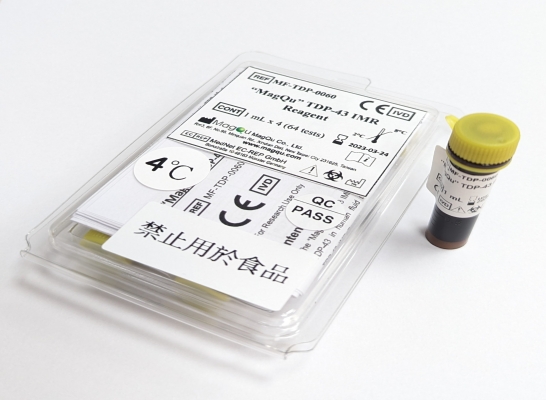Product

“MagQu” TDP-43 IMR Reagent
- Catalog No. MF-TDP-0060
- CE-IVD Certification
- For rapid quantifying TDP-43 by ImmunoMagnetic Reduction (IMR).
- Quantifying TDP-43 in the sample easily, rapidly, and accurately
- Magnetic Nanoparticle
- Dextran layer
- For ALS, FTLD and Alzheimer’s disease research and for in-vitro diagnosis use
Intended Use
“MagQu” TDP-43 IMR Reagent is used to quantitatively measure TDP-43 protein in human fluid specimen, such as plasma, serum or CSF.
Use “MagQu” TDP-43 IMR Reagent only with the XacPro-S System (MagQu Co., Ltd.).
Introduction
The TAR DNA binding protein of 43 kDa (TDP-43) is a ubiquitously expressed nuclear protein with roles in transcription and splicing regulation. A hyper-phosphorylated, ubiquitinated and cleaved form of TDP-43, known as pathologic TDP-43 is the major disease protein in ubiquitin-positive, tau and α-synuclein-negative frontotemporal dementia (FTLD-TDP, previously referred to as FTLD-U) and in amyotrophic lateral sclerosis (ALS). Evidences indicates that TDP-43 can be detected in human plasma and CSF and levels are reportedly elevated in cases of ALS, FTLD and Alzheimer’s disease. 1,2
Principle of Test
“MagQu” TDP-43 IMR Reagent is designed for rapid quantifying TDP-43 by ImmunoMagnetic Reduction (IMR). We conjugate antibody on the surface of around 50 nm-in-diameter Fe3O4 magnetic particles. When the antibodies on the surface bind with TDP-43, the magnetic particles form clusters. Therefore, the ac susceptibility (Xac) of magnetic particles would be reduced in the adding ac magnetic field. By measuring the reduction of Xac, TDP-43 can be easily, rapidly and accurately quantified.3
References
1. Foulds, P., McAuley, E., Gibbons, L., Davidson, Y., Pickering-Brown, S. M., Neary, D., Snowden, J. S., Allsop, D., Mann, D. M. (2008). TDP-43 protein in plasma may index TDP-43 brain pathology in Alzheimer's disease and frontotemporal lobar degeneration. Acta neuropathologica, 116(2), 141-6.
2. Feneberg, E., Gray, E., Ansorge, O., Talbot, K., & Turner, M. R. (2018). Towards a TDP-43-Based Biomarker for ALS and FTLD. Molecular neurobiology, 55(10), 7789-7801.
3. C.C. Yang, S.Y. Yang, C. S. Ho, et al., "Development of antibody functionalized magnetic nanoparticles for the immunoassay of carcinoembryonic antigen: a feasibility study for clinical use" J Nanobiotechnology. 12: 44. 2014.
| Catalog Number | Description | Package Size |
|---|---|---|
| MF-TDP-0060 | CE-IVD | 1 mL x 4 (64 tests) |
| MF-TDP-0060R | For Research Use Only | 1 mL x 4 (64 tests) |
- Applications Content:Quantitative detection for ultra-low-concentration bio-molecules, e.g. ALS, FTLD and Alzheimer’s disease bio-markers in blood.






